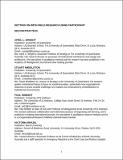Files in this item
Getting on with field research using participant deconstruction
Item metadata
| dc.contributor.author | Wright, April | |
| dc.contributor.author | Middleton, Stuart | |
| dc.contributor.author | Hibbert, Paul Charles | |
| dc.contributor.author | Brazil, Victoria | |
| dc.date.accessioned | 2018-07-19T15:30:04Z | |
| dc.date.available | 2018-07-19T15:30:04Z | |
| dc.date.issued | 2018-07-15 | |
| dc.identifier | 253160019 | |
| dc.identifier | 3e183200-d54d-4bd2-a263-95bae9173c05 | |
| dc.identifier | 85049953161 | |
| dc.identifier | 000516860500003 | |
| dc.identifier.citation | Wright , A , Middleton , S , Hibbert , P C & Brazil , V 2018 , ' Getting on with field research using participant deconstruction ' , Organizational Research Methods , vol. OnlineFirst . https://doi.org/10.1177/1094428118782589 | en |
| dc.identifier.issn | 1094-4281 | |
| dc.identifier.other | ORCID: /0000-0002-2691-2556/work/64239354 | |
| dc.identifier.uri | https://hdl.handle.net/10023/15600 | |
| dc.description | We acknowledge the support of the Australian Research Council in providing funding for this project under Linkage Project grant LP0989662 and Discovery Project grant DP140103237. | en |
| dc.description.abstract | This paper adds to the repertoire of field research methods through developing the technique of ‘participant deconstruction’. This technique involves research participants challenging and re-interpreting organizational texts through the application of orienting, disorienting and re-orienting deconstructive questions. We show how participant deconstruction complements existing strategies for ‘getting on’ with field research – cultivating relationships, developing outsider knowledge and mobilising insider knowledge – by facilitating research participants’ questioning and challenging of organizational texts and thus opening up alternative latent understandings, illuminating concealed meanings and supporting reflexivity for participants and researchers, thereby opening up fruitful lines of inquiry. We illustrate the application of the technique with examples drawn from healthcare research projects. Through gathering further practitioner feedback from a variety of alternative contexts, we go on to demonstrate the potential application of participant deconstruction in a range of field contexts, by different types of practitioners undertaking deconstructive readings of a wide variety of organizational texts. We also offer suggestions for further research to extend the technique. | |
| dc.format.extent | 864054 | |
| dc.language.iso | eng | |
| dc.relation.ispartof | Organizational Research Methods | en |
| dc.rights | Copyright © 2018, SAGE Publications. This work is made available online in accordance with the publisher’s policies. This is the author created, accepted version manuscript following peer review and may differ slightly from the final published version. The final published version of this work is available at https://doi.org/10.1177/1094428118782589 | en |
| dc.subject | Qualitative Research | en |
| dc.subject | Deconstruction | en |
| dc.subject | Healthcare management | en |
| dc.subject | Field research | en |
| dc.subject | Research relationships | en |
| dc.subject | Texts | en |
| dc.subject | HD28 Management. Industrial Management | en |
| dc.subject | T-NDAS | en |
| dc.subject.lcc | HD28 | en |
| dc.title | Getting on with field research using participant deconstruction | en |
| dc.type | Journal article | en |
| dc.contributor.institution | University of St Andrews.School of Management | en |
| dc.contributor.institution | University of St Andrews.Office of the Principal | en |
| dc.identifier.doi | 10.1177/1094428118782589 | |
| dc.description.status | Peer reviewed | en |
| dc.date.embargoedUntil | 2018-07-15 |
This item appears in the following Collection(s)
Items in the St Andrews Research Repository are protected by copyright, with all rights reserved, unless otherwise indicated.

